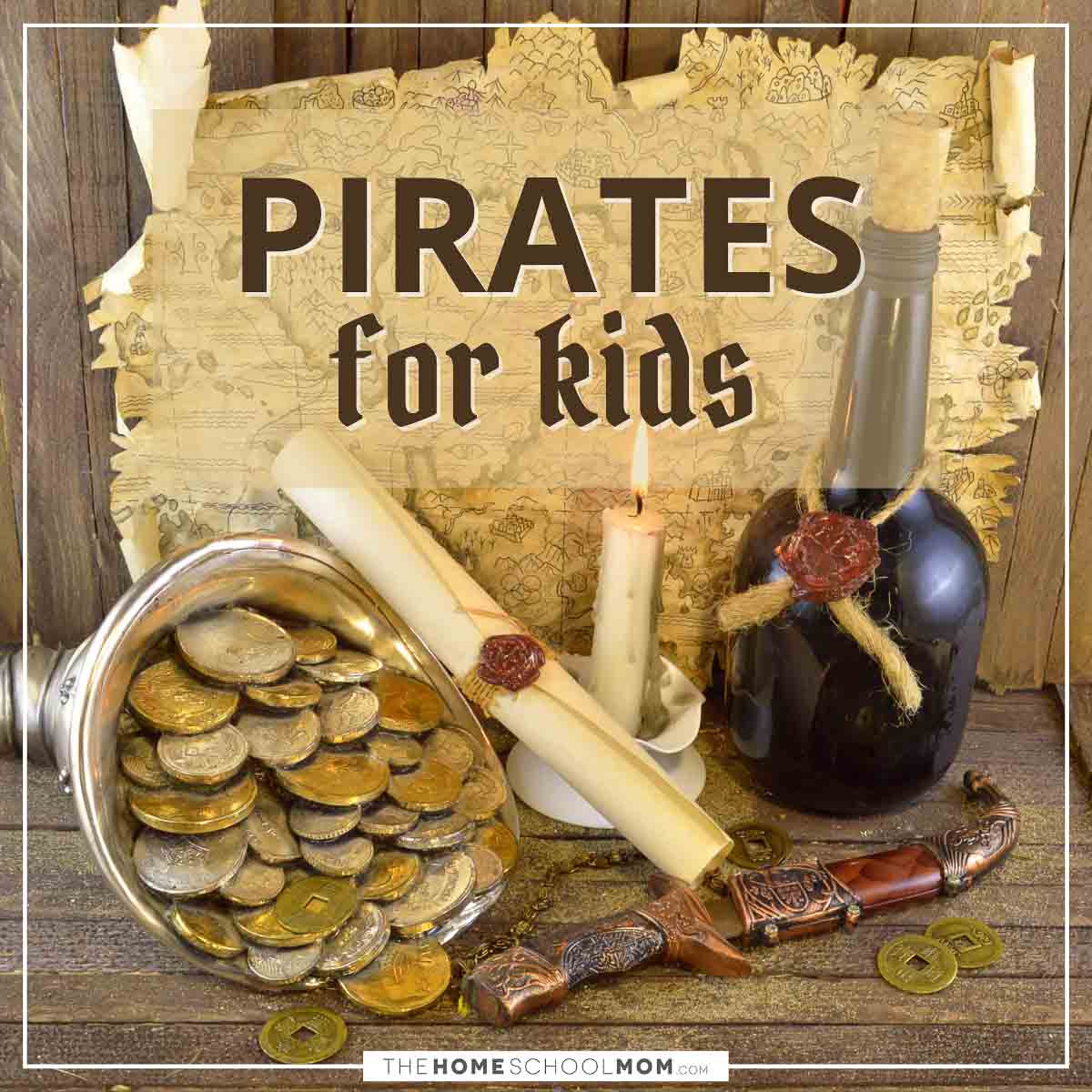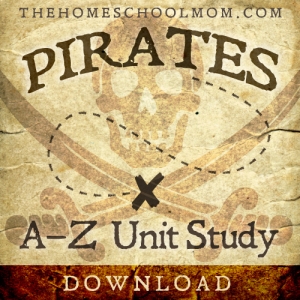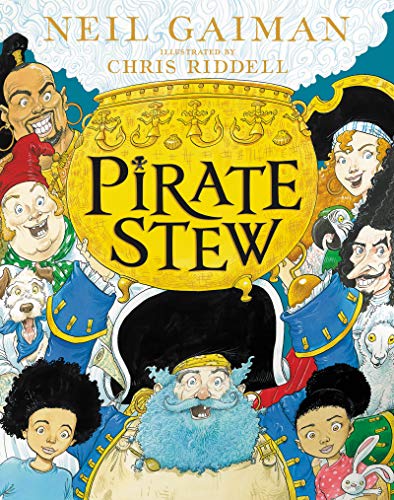Pirate lore is part social studies, part pop culture, and part fantastical-lots of kids love learning about pirates!
Together, you and your kids can read pirate stories, create treasure maps, and learn the locations of islands and oceans. You can learn about infamous pirates and their well-known ships. Learn about their pirate booty and illicit trading.
If you're planning a trip to the beach, make a pirate unit study part of your adventure. Often, East Coast and Gulf of Mexico beach towns have bookstores with titles (and storytellers) about the pirates who sailed off their shores. Visiting local museums-and even the local library at the beach-may provide you with enriching programs about pirates.
This Pirates A-Z Unit Study gives you lesson plans, resources and activities to help your kids learn academically through an interesting topic.

What Kids Will Learn
Practice Skills with Pirate Lore
When pirates are the topic, you have opportunities to help your kids:
- Build vocabulary and comprehension
- Practice handwriting and writing composition
- Solve puzzles and consider mysteries
- Read stories and novels
- Practice map skills
- Play dress-up, pretend, and use their imaginations!
- Create arts and crafts
Learn Social Studies Through Pirates
- Help kids understand history during the Golden Age of Piracy
- Help teens learn current events as they discover more recent acts of piracy (parent guidance required)
- Help kids explore the field of archaeology
- Help kids learn geography
Practice Critical Thinking Through Pirates
Help your kids understand which parts of the pirate lore they are learning is:
- Fact or fiction
- For fun or for real
- Exaggerated for entertainment
- Part of history
Experience a Deep Dive
For kids who are all in on pirates, consider focusing on one pirate, to create depth as well as breadth in your study of pirates.
For example, Blackbeard's pirate ship was the Queen Anne's Revenge (QAR), which ran aground off the North Carolina Coast in 1718-and which has been rediscovered just offshore!
Check out these links:
- When QAR ran aground
- What QAR looked like
- What QAR artifacts have been found
- How QAR started as a slave vessel-with a different name
Which pirate would your kid like to learn more about?
Remember the Dark Side of Pirates
Pirates may be portrayed in pop culture as adventurers on the high seas or comical stereotypes. Kids can also learn about the very real impact of piracy. Pirates plundered ships and stole their goods, and some pirates played a real part in the international slave trade.
Because piracy was a real occupation and many of the historical topics are mature in nature, the listed online resources may contain content that you find objectionable. We have curated resources that are as child-friendly as possible, but please preview all resources before sharing them with your children.
Pirates Unit Study

Children will gather information on the history of pirates, where they sailed, what their lifestyles were like, what jobs they did, how they dressed, how they divided their spoils, and more.
Sign up below to get the Pirates Unit Study printable to use with the activities on this page!
Pirate Lesson Plans
These pirate lesson plans make up a pirate unit study. Our pirate unit printable is free to newsletter subscribers (subscribe above), and you can print a copy for each student to use to complete their work.
The pirate lessons are general in nature to allow you to adapt them based on the age of your child(ren). You may wish to pick and choose the activities your children will most enjoy.
For younger children, parents can work with the children to discover information about pirates. Activities for younger children can be completed orally if desired. Older children can do their own research online or at the library.
Start your pirate unit with a trip to the library to pick up some interesting pirate books for kids.
Pirate History
Background Information
Although piracy was first documented in the ancient world and still exists today, most people associate pirates with those operating in the North Atlantic and Indian Oceans during the Golden Age of Piracy between the 1650s and the 1730s.
The activity pirates engaged in-robbery by ship often accompanied by violence-was not limited to outlaw pirates. Privateers working under government license (proven by a letter of marque) were authorized to attack and capture merchant ships of enemy nations. They engaged in similar activities as pirates from the mid-16th to mid-19th centuries.
Privateers operated under the rules of war and were only licensed to attack targets specifically listed in the letter of marque. They also had to share the proceeds of the prize between the sponsors, captains, crew, shipowners, and the issuer of the license.
Privateers may have been acting in a way that was legally permitted by the licensing country, but if they were captured by an enemy nation, they might have been charged as a pirate.
During the Golden Age of Piracy, many pirates operated as privateers and pirates at different times (or at the same time if they strayed beyond the activities permitted in their license).
Depending on the current laws of their country, individuals who had been legally working as privateers may have found themselves outside of the law at the end of a war. Some continued pillaging without the cover of a license, while others took advantage of royal pardons.
In the interest of reducing piracy after the end of privateering during armed conflicts, several different proclamations offering pardons for piracy were issued by the monarchs of Great Britain. These began in the early 17th century and continued off and on throughout the 1600s. The 1717 Proclamation for Suppressing of Pirates (or the Act of Grace) issued by King George I is the most famous of the pardons.
Online resources:
- Did You Know Pirates Were Granted a Pardon?
- Golden Age of Pirates
- The life and times of a pirate (includes podcasts)
Activity: Pirate History
Have students look up and define the following terms and explain how they overlap:
- Pirates
- Buccaneer
- Corsair
- Privateer
Online resources:
Activity: Pirate Timeline
- Have your child make a list of two or three pirates known to have operated in each of the following centuries: 1500s, 1600s, 1700s, 1800s, 1990s and current day.
- Help them create a timeline using the data they discovered.
Online resource:
Activities: Pirate Maps
- Using their timeline and the Pirates on the Seven Seas world map, have children color in the geographic areas where pirates are known to have sailed. Encourage them to make the map easy to read by using a different colored pencil or creating a unique symbol for each pirate. Have them be sure to include a legend at the bottom of the map.
- Based on the information learned, ask children if the location where pirates sailed changed over time. If so, have them make educated guesses about why they think that is. In the space provided below the map, have them write one paragraph listing three reasons to support their answer.
Online resource:
Activity: Famous Pirates
Have your child(ren) select from one to three famous pirates from history and write one paragraph about each, giving a brief biographical introduction and including the following information:
- where the pirate came from
- where (s)he sailed
- on which ship (s)he sailed
- why (s)he is considered famous
- how (s)he ended his career
Have them try to locate an image of the pirate, his ship, or his custom flag.
Online resources:
- Queen Anne's Revenge Educational Resources (Blackbeard)
- Pirate Profile: Mary Read
- Notorious Pirates in History
- Did You Know? The US has a history of women pirates (NPS)
- Wikipedia's chronological list of pirates
Activities: Pirate Flags
For many years, pirates flew simple red flags. Starting in the Golden Age of Piracy, personalized flags became an identifier for each pirate. Using books or the internet, ask your students to do the following:
- Explain what flags flown on pirate ships are named. How did they get their special name?
- List some of the symbols commonly found on these famous flags.
Using art supplies, have students draw or cut and paste representations of pirate flags:
- Have children select and illustrate three of the flags from the research.
- Have children create a flag of their own and include a special symbol that is important to them.
Online resources:
- Pirate Flags - Fearsome Banners of Centuries Past
- The History of Pirate Flags
- Did You Know Blackbeard's Flag Is a Modern Design?
Activity: Types of Pirate ships
Have students look up and describe the following types of pirate ships:
- Barque
- Brigantine
- Caravel
- Frigate
- Junk
- Sloop
- Schooner
- Square-Rigger
Online resources:
- Pirate Glossary: Ships
- Varieties of Pirate Ships
- Sea History for Kids: Vessels
- Rigged to Blow: Sailing a Square-Rigged Vessel
Activity: Famous Pirate Ships
Have students investigate three famous pirate ships. For each ship, have them write a paragraph telling:
- who built it
- what its purpose was before it was captured by pirates
- what materials it was made of
- who sailed on it
- where it sailed
- what became of it when it was no longer being used by pirates
Online resources:
Pirate Treasure Math
Have students work out the following word problem to show how math was important to pirates.
Activity: Divide the Booty
Pieces of eight (POE) were Spanish coins that had been cut into eight pieces for ease of spending.
A Man 'O War frigate could carry a full crew of 190 pirates. When the ship returned to the Caribbean, the crew had acquired 900 pieces of eight. The crew count was at 90% when the Quartermaster began to divide the booty. The Captain receives two shares, the Quartermaster receives 1.5 shares, and the two Gunners receive 1.25 shares of the money. The remaining crew receives 1 share each except for the two newest cabin boys, who only receive ½ share each.
- How many crew members are on the Frigate?
- How many shares total must the booty be divided?
- How much do the Captain, the Quartermaster, the Gunners, the remaining crew and the apprentice cabin boys receive?
- How much is remaining?
Bonus Questions:
Place 20% of the booty in reserves on the ship for future payments. These payments would be to compensate pirates for loss of limb or loss of eye during their voyage.
- How many pieces of eight are remaining after restocking 20%?
- How many pieces of eight are held in reserves?
- How much do the Captain, the Quartermaster, the Gunners, the remaining crew and the apprentice cabin boys receive?
- How much is remaining?
Alternate pirate math activity for younger children:
Tip: Allow children to use base ten manipulatives to solve the problem.
A pirate ship had a crew of 100 pirates, not including the Captain. The crew had 1000 pieces of eight (PoE) to split after the Captain took his share. How many pieces of eight does each member of the crew receive?
Pirate Terminology
Online resources for the below activities:
Activity: Pirate Jobs
- Have students research and list the types of jobs pirates did on their ships and give a brief job description for each one.
Example: First Mate - the first mate was the Captain's right-hand man and would assume command of the ship if the Captain unexpectedly became wounded or killed in battle. The first mate would need to have experience in navigation and leadership skills. - Jobs on Land vs. Jobs at Sea - Explain how Venn diagrams are used to show overlap. Using the Pirate Jobs on Land vs. Sea Venn Diagram, have students list jobs pirates did on land and the jobs they did at sea. For jobs that overlapped, have them put those jobs where the circles intersect.
Activity: Pirate Dress Code
Print and complete the Pirate Dress Code crossword puzzle worksheet. (Pirate Dress Code crossword puzzle answer key)
Activities: Nautical Terms
- Print and have students complete the Nautical Terms word search worksheet. (Nautical Terms word search answer key)
- Have students look up information on each of the following navigational tools. In the space provided on the Nautical Terms Wordsearch worksheet, have them describe how to use the tools. Each of these tools can still be used today.
- Sundials
- Dividers
- Backstaff
- Spyglass
- Compass
Activity: Pirate Punishment
Have students find out what the following punishments meant (use discretion with sensitive children):
- Moses' Law
- Cat-o-nine Tails
- Marooning
- Sweating
- Keelhauling
Activity: Pirating Vocabulary A to Z
Have students discover how the following terms and people are important to the pirate world:
A - Anne Bonny
B - Buccaneer
C - Cat-o-nine-tails
D - Davy Jones Locker
E - Edward teach
F - Flying Dutchman
G - Granuaille AKA Grace O'Malley
H - Henry Morgan
I - Island, specifically Padre Island
J - Jolly Roger
K - Keelhauling
L - Lubber
M - Moses' Law
N - Navigational tools
O - Oak Island
P - Powder Monkey
Q - Queen Anne
R - Rachel Wall
S - Sam Bellamy
T - Tortuga
U - Unique "Motley" clothing
V - Vane, Charles
W - Whydah
X - X marks the spot - Treasure maps
Y - Yardarm
Z - Zodiac Constellations (Celestial Navigation)
Hands-On Pirate Activities & Crafts
Bring your pirate unit to life with an easy-to-make pirate costume or puppet, a homemade compass, pirate flag cookies, and more.
Pirate Books for Kids
 |
 |
 |
 |
 |
Pirate Books Online
Pirates, Pirates, Pirates, stories selected by Phyllis R. Fenner, published 1914
Buccaneers and Pirates of Our Coasts by Frank R. Stockton, published 1898
Treasure Island by Robert Louis Stevenson, published 1915
Howard Pyle's Book of Pirates by Howard Pyle, published 1921
A Nation of Pirates: English Piracy in Its Heyday by Clive M Senior, published 1976
Pirate Video & Audio for Kids & Teens
The Definitive History of Pirates (Animated YouTube)
Curious Kid Podcast, "Curious About Pirates" episode
The Great Courses, "The Real History of Pirates," 24 college lectures on Audible - for teens and adults













